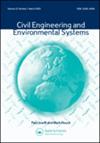揭示城市系统系统性影响的风险不可知论模型
IF 1.1
3区 工程技术
Q3 ENGINEERING, CIVIL
引用次数: 2
摘要
为了增加工程师的工具包来应对21世纪的挑战,我们展示了一个新的系统模型来理解城市影响。该模型捕捉了城市中不同互联系统(或部门,如娱乐服务或公共医疗保健)之间的相互依赖关系,从有形的(如道路等资源)到更无形的(如可持续经济等成果)。该模型是危险不可知的,因为它可以被修改,以捕捉不同冲击对系统有形部分的影响,以及这些影响如何级联到更抽象和高层次的城市任务和结果。本文演示了三种假设情景(洪水、干旱和流行病)及其对普通英国城市的影响。使用网络分析,可以跟踪和解释影响,以帮助优先考虑恢复力建设的需求。我们建议其他致力于应对可持续发展目标等全球挑战和解决城市系统互联互通问题的机构采用和测试这一新工具。本文章由计算机程序翻译,如有差异,请以英文原文为准。
A hazard-agnostic model for unpacking systemic impacts in urban systems
ABSTRACT To add to the engineer’s toolkit for the twenty-first century challenges, we demonstrate a novel systems model for understanding urban impacts. The model captures interdependencies between different interconnected systems (or sectors, e.g. recreational services or public healthcare) in cities, from the tangible (e.g. resources such as roads) to the more intangible (e.g. outcomes such as the sustainable economy). The model is hazard-agnostic in that it can be modified to capture the impacts of different shocks on tangible parts of the system and how these cascade through to more abstract and high-level city tasks and outcomes. This paper demonstrates three hypothetical scenarios (a flood, drought, and pandemic) and their impacts on a generic UK city. Using the network analysis, impacts can be tracked and interpreted to help prioritise requirements for resilience-building. We propose this new tool be taken up and tested by others working to address global challenges such as the Sustainable Development Goals and grappling with the interconnectedness of urban systems.
求助全文
通过发布文献求助,成功后即可免费获取论文全文。
去求助
来源期刊

Civil Engineering and Environmental Systems
工程技术-工程:土木
CiteScore
3.30
自引率
16.70%
发文量
10
审稿时长
>12 weeks
期刊介绍:
Civil Engineering and Environmental Systems is devoted to the advancement of systems thinking and systems techniques throughout systems engineering, environmental engineering decision-making, and engineering management. We do this by publishing the practical applications and developments of "hard" and "soft" systems techniques and thinking.
Submissions that allow for better analysis of civil engineering and environmental systems might look at:
-Civil Engineering optimization
-Risk assessment in engineering
-Civil engineering decision analysis
-System identification in engineering
-Civil engineering numerical simulation
-Uncertainty modelling in engineering
-Qualitative modelling of complex engineering systems
 求助内容:
求助内容: 应助结果提醒方式:
应助结果提醒方式:


